


The Johnson
Family Homestead
|
Problems with this site?
Contact us: Support at Texas Idea Farm
Cactus Eradication Page
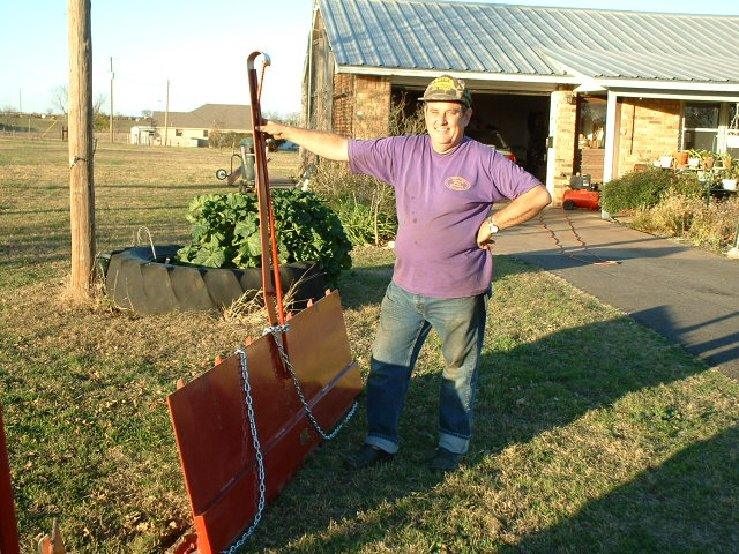
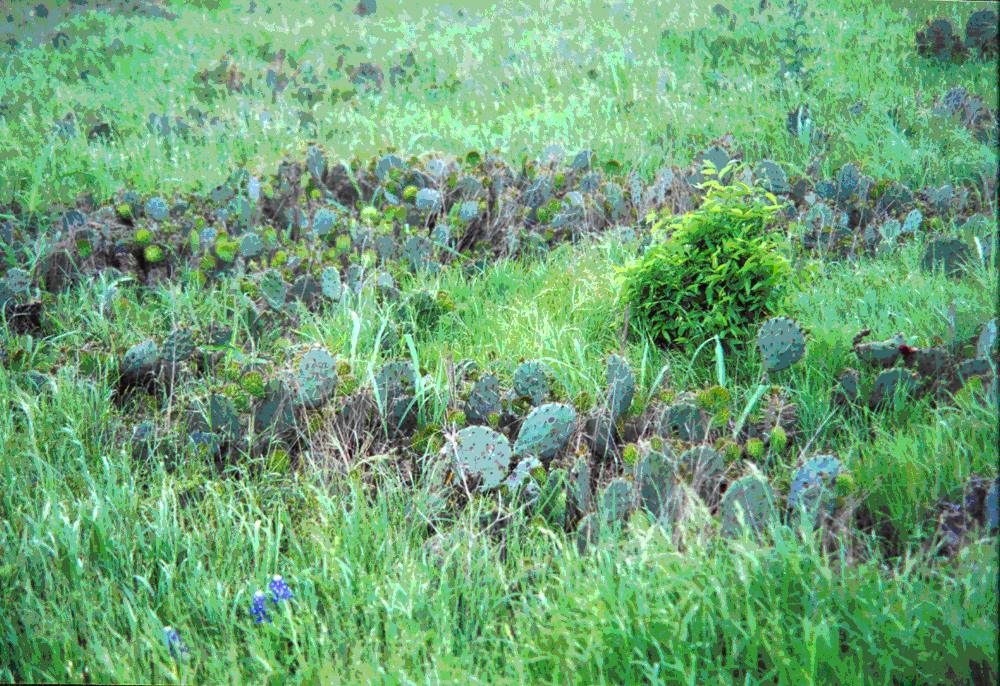

Understanding Prickly Pear Cactus:
Prickly pear has aboveground foliage comprised of thorn-covered pads (leaves), and a below-ground root system.
The pads depend upon the roots for sustenance, and vice versa. The green pads make nutrients
by photosynthesis, using water absorbed by the root system. Water and nutrients are stored throughout
the plant, but a great deal of it is stored in the pads, especially in the smaller plants.
Prickly pear pads are quite easily broken off, being of a rather brittle character, as green foliage goes.
Pads otherwise not damaged laying upon the ground will rapidly put down roots from the thorn sites, creating
new plants. This is a race against time: rooting must take place before the moisture in the pad dries out,
but prickly pear is well-adapted to do exactly this process.
Small plants have small root systems, which will not survive long without aboveground green foliage.
Large mature plants will have large underground root systems (the so-called “cactus potatoes”), which store large
quantities of moisture and nutrients. Where the pads have been removed, small root systems tend to be
unsuccessful re-growing aboveground foliage in time to survive, while larger plants easily and quickly
re-establish themselves.
These characteristics are both the cactus’s great strength, and also its “Achilles Heel”, if you understand them
well enough to take advantage, and you use the correct tools.
Killing Prickly Pear Chemically:
There are spray herbicides that will kill prickly pear. Chemical control is the best-known method,
but it is only that: control, not eradication. And, it is very expensive (on the order of $50/acre).
It usually takes 2-3 years for about 70% of the sprayed cactus to die. That leaves
quite a lot of cactus still infesting your pasture. Furthermore, every 3-5 years in perpetuity,
you are out that great expense again, just to achieve control. Finally, there is always the risk
of contamination of your land and water resources, and the farm animals that depend upon them, with very
dangerous chemicals.
Killing Prickly Pear with a Shredder:
This actually can be done, but it is hardly worthwhile. It is way too much work.
GW’s neighbor Bud did it with an ordinary shredder. Every single weekend, all day long, and some days
in mid-week, Bud was out there shredding, at one inch high. After the first year, Bud’s place was
solid cactus, one inch high.
After six years of “every weekend-plus”, the cactus finally died and went away, permanently. Bud’s
place was only 35 acres. The fact that his cactus finally died was one of several clues toward the
successful invention and development of GW’s “Kill Your Cactus System” tool.
GW’s Kill Your Cactus System process killed the cactus on his place in only several months, with dramatically less
actual work. GW invested experimentally a total of about 4 hours an acre on his place, and it
turns out that 2-3 hours/acre will work just as well.
Bud was initially skeptical, but he is a firm believer now.
How To Kill Prickly Pear Cactus By Mechanical Means, Permanently and Safely:
To kill the aboveground green foliage (the pads), you first have to separate them from their source of moisture
(the root system). That part is easy. Any object impacting the plant will knock loose pads,
which fall in the direction the impacting object is moving. Almost any physical object will do this
job just fine.
But, secondly, you must keep those fallen pads from re-rooting. If you fail to do this, then eventually
you will simply have spread the cactus further, and created more of it. This re-rooting process, plus
re-vegetation from the larger root systems, only takes a few months. It happens, at various rates,
year round, too.
There are only two ways to accomplish this second critical objective: (1) pick the cactus pads up
for disposal, or (2) do enough damage to them to cause them to bleed out dry and die, before they can successfully
re-root.
The first alternative is a lot of dirty, labor-intensive, very unpleasant work. You get a lot of
thorns and tiny prickles in your skin, all over your body. (I know, I have done this -- GW).
The second alternative requires the right kind of tool, one that will do the necessary damage to the pads as it
knocks them down. That tool is the “Kill Your Cactus System”.
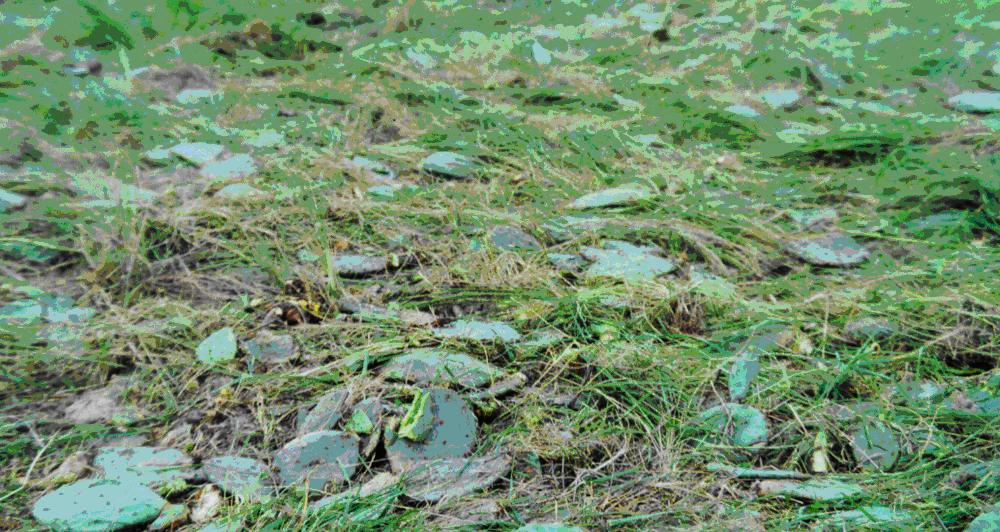
Shredding and mowing do not do enough damage to the pads. These are nothing but clean cuts
through the pads. Each piece has enough moisture to last until re-rooted, even though the shredding
cuts bleed. This pest really is well-adapted for survival. (I know, I have done this, too.
It does not work. There is an improved appearance initially, but it is only temporary -- GW).
Blading without disposal, chaining, and towing simple pieces of rail or structural pieces of steel to knock
over the cactus do not work, because they do almost no damage at all to the pads. They merely push
the cactus around a bit. (I know, I have also done these. None of them work.
There is an improved appearance with these methods, but again it is only temporary -- GW).
If you do this process right, with the correct kind of tool, the pads will compost in place without any pick-up
and disposal at all. The labor reduces to driving a tractor while employing the “right tool”.
This combination of tool and process actually works, and if you do the whole process, it is permanent.
(This is what I discovered and developed, after doing it wrong for 15 years -- GW).
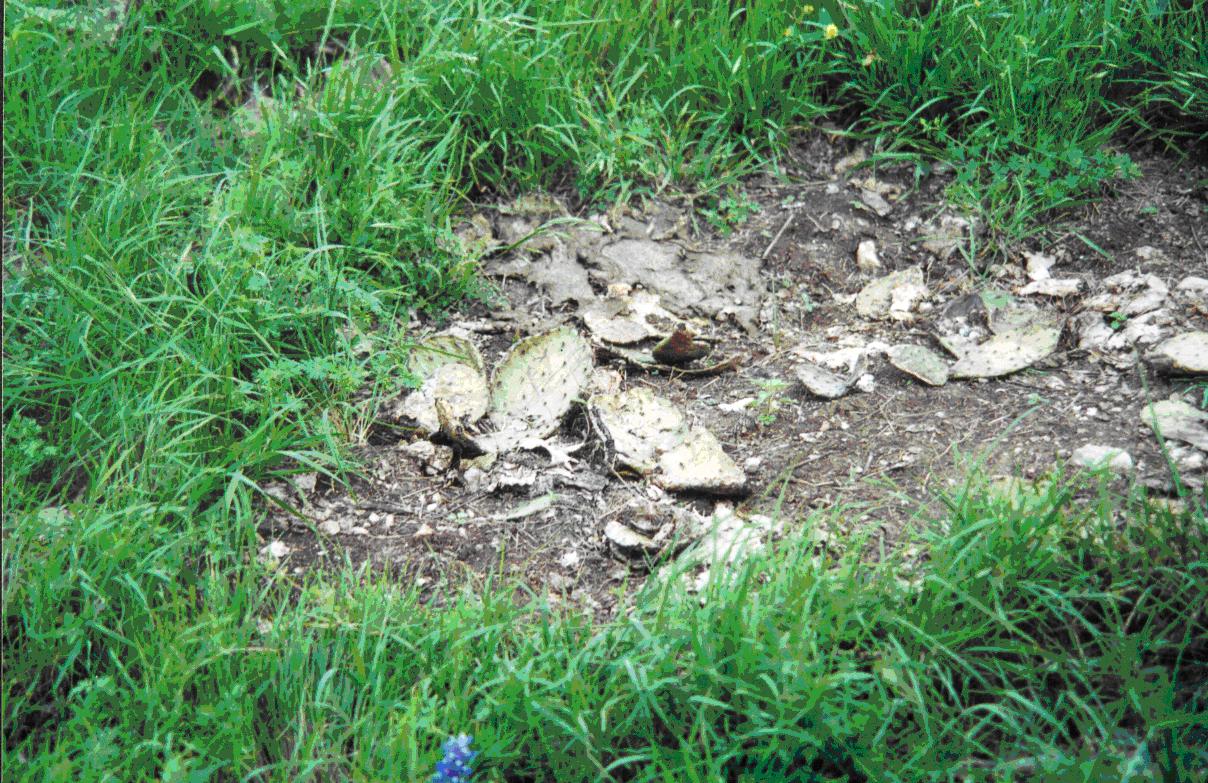
That “right tool” (the “Kill Your Cactus System”) is what this page is all about.
Getting a permanent “kill” requires also that you kill the root systems, so that they cannot send up
new foliage. If you can keep the aboveground foliage destroyed for 2-3 years, even the largest
“root potatoes” starve for lack of photosynthesis. That is the permanent “kill”.
Unlike chemicals, mechanical eradication actually has an end to it.
The “Kill Your Cactus System”, for Your Cactus Eradication Job:
I discovered this approach accidentally, while trying to build a “scooper-upper”. The scooper did not work.
Disgusted, I left my experimental device in the pasture for many weeks. When I returned to salvage the
steel, I found it had killed all the prickly pear that it had run over instead of scooping up. With a
little development, this basic design became the “Kill Your Cactus System”, which I patented (US patent number 6,722,446) in
2004 -- GW.
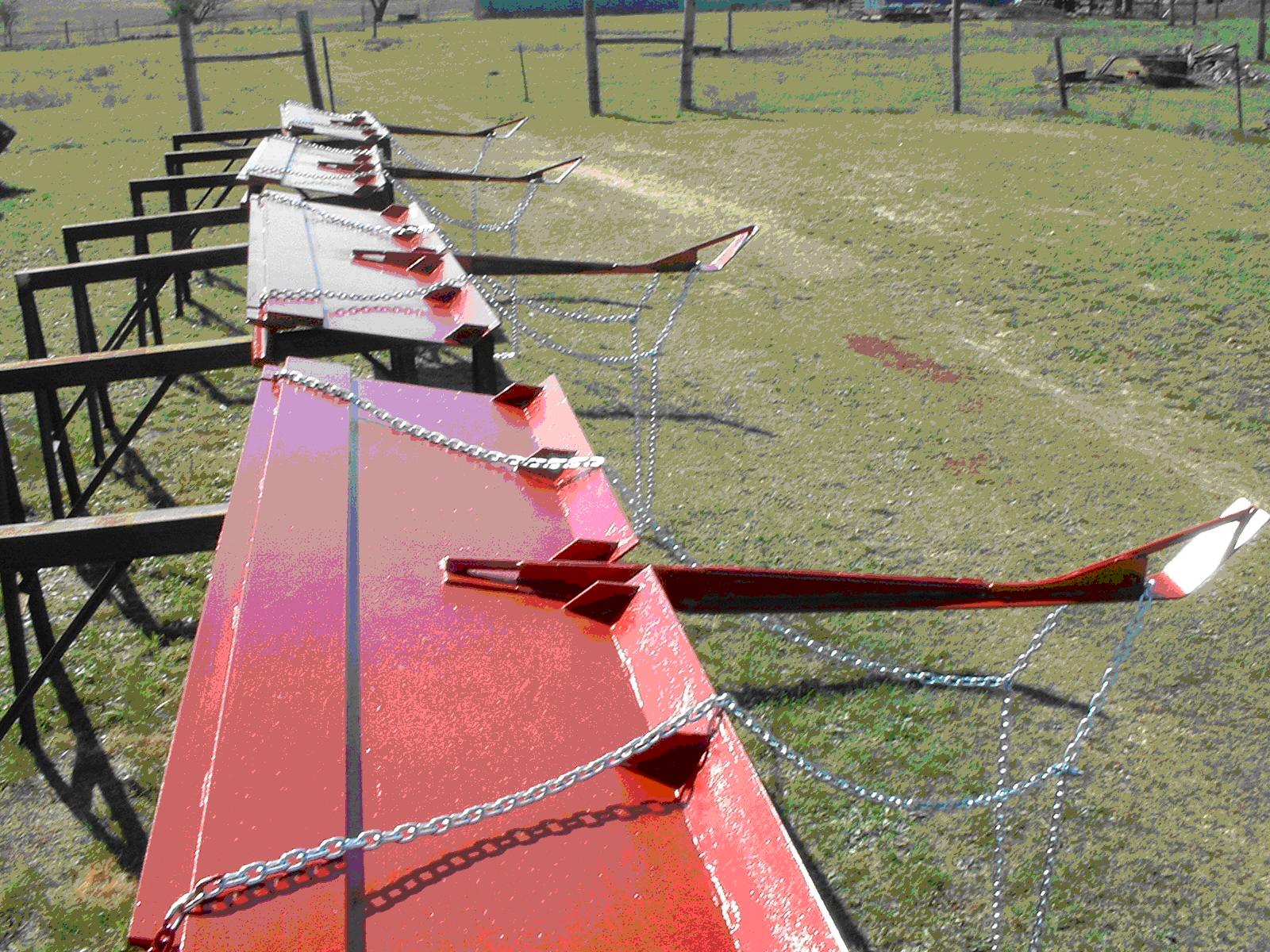
The essential cactus-killing features of the tool are the deck plate, the piece of railroad rail at the rear,
and a one-inch gap above ground at the leading edge. These pieces create a triangular space in which
cactus parts are temporarily trapped. The leading edge of the tool knocks the pads partially apart
as it knocks the plants down, separating them from their roots. They tend to fall in front of the tool,
not on top of it. Passing through the one-inch gap tends to break the plants apart into individual
pads or small pieces of plants, as the tool rides over the top of the cactus debris. Once underneath,
the pads get rolled over and over as the ground slides by beneath, and thus they are subjected to lots of folding
and bending action. Then they get thoroughly crushed, while squeezing out from under the heavy rail
at the back.
Because prickly pear pads are brittle, this bending and crushing process cracks the pads internally, creating
many extra paths inside each pad for moisture to bleed out quickly. That is why prickly pear debris
treated by the Kill Your Cactus System will bleed out dry and die before it can put down new roots, unlike all other
known mechanical tools and processes.
The rest of the features of the tool design merely aid it to perform this function in a safe and reliable manner.
There is a snout on the front to prevent the tool from flipping over. All of the tools currently built
for sale today have a sort of “barge front” built onto the leading edge, which helps them pry their way over rocks
and rocky outcrops. There is ballast added to provide the crushing weight, and positioned to
distribute this correctly onto the rail. There is a simple tow chain bridle that fits any sort of hitch.
All of the above features are included in the homeowner-grade tool, in a form
that has no moving parts. In the commercial version, there are
retractable transport wheels, which can be operated hydraulically, electrically,
or manually. The commercial version also has a larger and stronger
snout. The relationship between the homeowner-grade tool and the
commercial-grade tool is analogous to the relationship between a hand-held
drill and a drill press: both drill holes; the drill press (and the commercial
grade Kill Your Cactus System) simply handle much bigger jobs, and cost more.
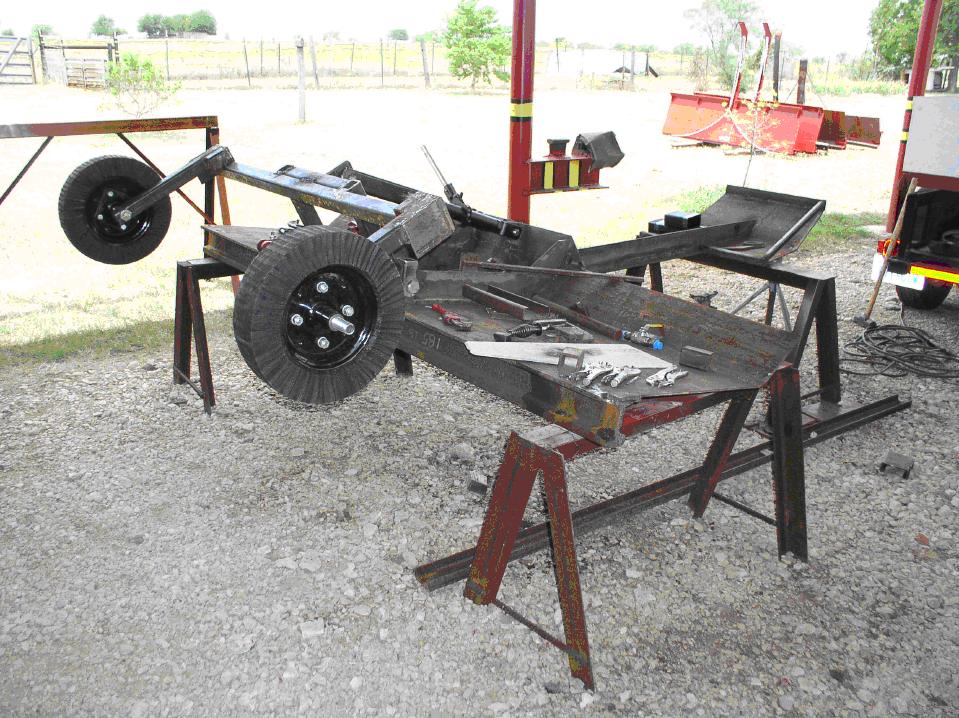
How To Get Help Killing Prickly Pear:
GW is the man to contact. For current prices and availability, put “buy cactus tool” in the subject line, and contact G.W. by e-mail in McGregor, Texas, at gwj5886@gmail.com
For those wanting to pick up their own tools at GW’s place, bring a trailer or a pickup truck with sufficient capacity (usually half-ton or bigger, and at least 6.5 feet of bed, for our smaller, single homeowner-grade tool). The larger 'commercial-grade' tools are too big/heavy for his truck.
He builds and sells cactus removal tools in small batches, to individual customer order, money up front.
These incorporate a lot of purchased equipment and hand labor, weigh between 750-1500 pounds, with an 8-foot deck span (cut swath width), and cost in the neighborhood of $6,000 - 15,000 each, depending on model and features selected. Most tractors can pull at least two of them in the flatter country.
These tools come with a detailed how-to manual that explains exactly how to employ them successfully.
If you want to know more about the Kill Your Cactus System, there is an information kit available for the homeowner-grade tool, as a "PDF" download file, on www.killyourcactusnow.com. It has cactus eradication pictures, some descriptive information, and price / ordering information. (But be sure to check directly with GW for the most current prices and availability.) He usually builds these in batches of two to four units, but cannot always have one immediately on-hand for sale.
To see a recent television news story that features GW demonstrating one a commercial-grade tool, click the link below that takes you to the website of Waco station KWTX-TV Channel 10 News. Although short, this shows the tool in operation and explains briefly how it really works.